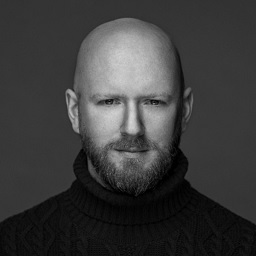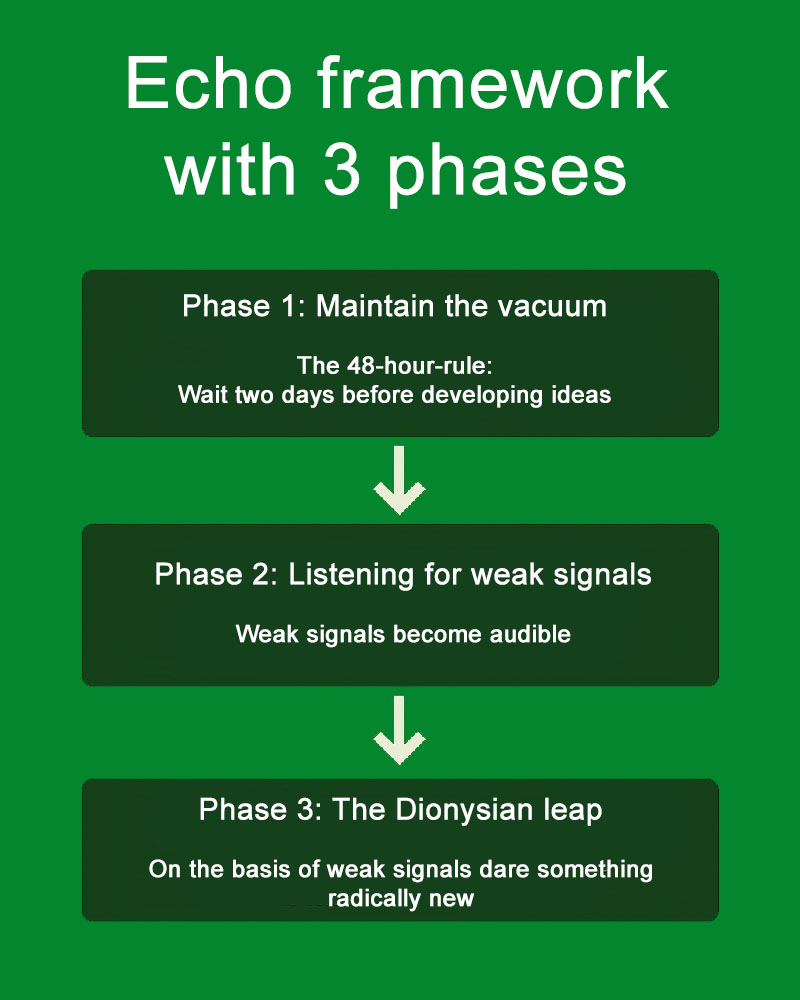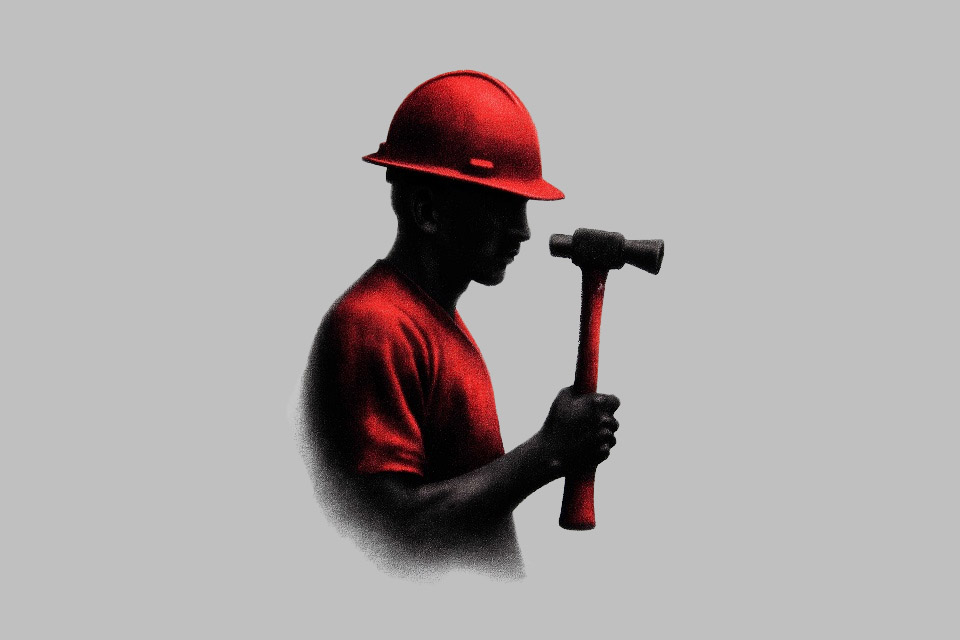The silence in a transformation
After the strategy with the hammer: What happens when the sound fades away?
Monday morning, 8:30 a.m. The managing director stares at the blank screen. The strategic off-site meeting was three days ago. The hammer had fallen, and the hollow spots were unmistakable: ‘Agile transformation’ – just a stage set. The ‘culture of innovation’ – monthly brainstorming sessions with no consequences. She now knows what doesn’t work. But what to do about it? The silence frightens her.
After the strategy with the hammer comes silence. That dangerous moment when old certainties have been shattered, but new ones have not yet emerged. It is the most critical moment of any transformation and, at the same time, the most underestimated.
Three escape routes from silence
The silence after the hammer is so dangerous because it offers three tempting escape routes:
Escape route 1: The repair illusion
‘Now that we know what’s wrong, we can fix it.’
Our managing director is familiar with this reflex. Her first reaction to the realisation of pseudo-agility was:
‘Then let’s do real sprints. Better retrospectives. More professional Scrum.’
This is the seduction of repair: making the old better instead of daring to try something fundamentally new. But those who repair have not understood the question. The hammer did not show that agility is being implemented poorly; it showed that the organisation may not want to be agile at all.
Escape route 2: The paralysis trap
‘If nothing is right, I can’t change anything.’
On the third day after the off-site, the managing director feels this heaviness. If the transformation was just theatre, the innovation just a façade, what is real? This paralysis feels like clarity, but it is only fear in academic garb.
Escape route 3: The actionism reflex
‘Quickly build new structures before the vacuum engulfs us.’
Your management team is already pushing for new consultants, a new framework, a new organisation chart. The main thing is to fill the uncomfortable void immediately. But this is also just a form of fear of not knowing.
The space between destruction and construction and the echo framework
This is where the real art of transformation lies: in maintaining the vacuum. Not repairing immediately, not falling into paralysis, not resorting to actionism, but consciously enduring the empty space.
It is the moment between the collapse of old value systems and the creation of new ones – the space in which genuine revaluation takes place. This is precisely where tantin’s echo framework with its three phases comes in: it is not about filling the silence, but about listening to it.
Phase 1: Maintain the vacuum
The first step after questioning is paradoxical: do nothing. Not in the sense of passivity, but in the sense of consciously refraining from reflexive solutions.
The 48-hour rule: After every fundamental insight into organisational weaknesses, wait two days before developing the first solution idea. During this time, our managing director only notes down questions:
- What does this insight reveal?
- What opportunities open up if we stop doing what we have been doing?
- What are we actually letting go of, and what remains?
Phase 2: Listening for weak signals
Something fascinating happens in the silence after the hammer falls: weak signals become audible. Ideas that were previously drowned out by the noise of routine.
After three days of conscious inaction, our managing director notices that ideas are suddenly emerging in coffee conversations that never came up in two years of strategy workshops. A young developer casually asks, ‘What if we just didn’t have any meetings for a month?’
The abductive leap: this is the moment when fragmented observations suddenly become a coherent pattern. Weak signals condense into strong hypotheses about what wants to emerge.
Phase 3: The Dionysian leap
The final and most courageous step: the leap into the unknown. No longer repairing the old, but daring to try something radically new based on the weak signals.
After a week of listening, an idea crystallises for the managing director: what if leadership does not mean having answers, but asking better questions? What if her role is not that of a decision-maker, but that of an enabler?
The Dionysian leap is not a plan; it is a risk. It does not require certainty, but trust in what wants to emerge.
Figure: Echo framework with 3 phases
The underestimated power of strategic silence
What organisations need most after the hammer blow is tolerance for ambiguity. The ability to endure not knowing without immediately resorting to familiar patterns. In a world that demands we always have answers, admitting that we don’t know is an act of rebellion.
In practice, two specific methods have proven effective:
The resonance chamber check
Three times a week, 15 minutes of silence. Three questions:
- What am I hearing today that I overlooked yesterday?
- Which weak signals are becoming stronger?
- What do I want to let go of today without replacing it?
The reduction experiment
Instead of adding something new, remove something superfluous every week. Without replacing it. Observe what happens in the space that is created.
Our managing director has made a decision: she will not make any strategic decisions for three months. Instead, she will conduct three experiments:
- One month without regular meetings.
- One month in which decisions are made by those who implement them.
- One month in which she only asks questions.
It is not her strategy. It is her leap.
Conclusion
Transformations often fail not because of a lack of ideas or energy, but because of a reluctance to question oneself before the market does, and an inability to tolerate the vacuum that follows questioning.
Those who repair too early, allow themselves to be paralysed or sink into actionism miss the opportunity for something truly new to emerge. The silence after the hammer blow is not a deficit, but raw material, the inconspicuous space in which weak signals become audible and radical perspectives mature.
The Echo Framework shows that only those who consciously do nothing learn to listen. Only those who listen recognise patterns. And only those who recognise them can take the leap into the unknown, without guarantees but with a greater chance of genuine renewal. Strategic silence is therefore not a luxury, but a leadership discipline.
A thought to take away
Perhaps the most important leadership quality of our time is not the ability to act quickly, but the art of consciously not acting. Not out of weakness, but out of the strength to give space to the new.
The question is not whether you have the courage to act. The question is: Do you have the courage not to act until you know what wants to emerge? And while you ponder this question, listen for a moment to the silence within your own organisation. What do you hear? What faint signals are waiting to be noticed?
Sometimes the biggest leap is the one you don’t take until the right moment has come.
Notes:
Are you an opinion leader who would like to discuss silence in transformations and conscious inaction? Then feel free to share this article on social media or within your network.
Constantin Melchers has published two more articles on the t2informatik Blog:

Constantin Melchers
Constantin Melchers has been supporting executives and top decision-makers at strategic turning points for over 20 years. As a consultant, former manager in various organisations and university lecturer, he combines practical experience with conceptual depth.
His approach is distinctive: strategy does not begin with planning, but with the willingness to question established patterns of thinking. ‘Many organisations fail not because of their methods, but because they imitate themselves out of habit.’
He understands transformation as a cultural act of self-overcoming, not as a management routine. With tantin Consulting, he has created a think & do tank that works selectively with medium-sized companies and organisations that are ready for real change. Instead of delivering standard recipes, he opens up spaces for resonance for sustainable change.
In the t2informatik Blog, we publish articles for people in organisations. For these people, we develop and modernise software. Pragmatic. ✔️ Personal. ✔️ Professional. ✔️ Click here to find out more.


